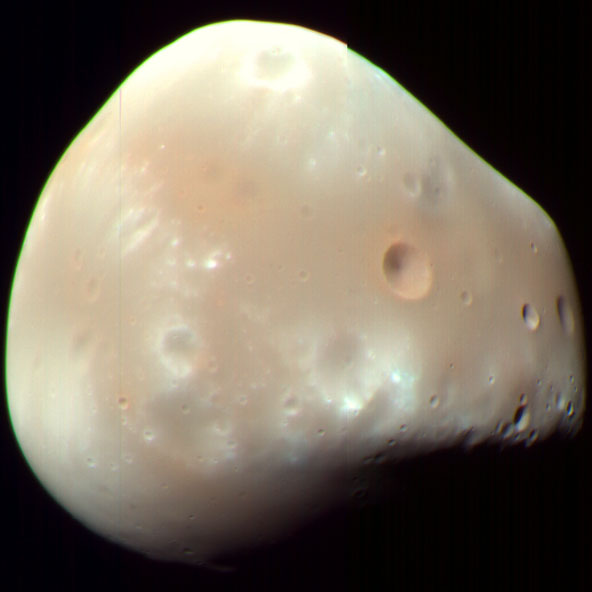The moons of Mars, aptly named for the sons of the god of war, Phobos (Fear) and Deimos (Panic) are more like asteroids than the larger moons we generally associate with planets. The moons are only 22 Km (phobos) and 12 Km (deimos) in diameter, and orbit their planet is 7 hours and 30 hours respectively.


The larger moon Phobos is moving toward its planet by almost 7 feet every year, due to the massive gravitational forces it feels from Mars. As it moves closer than its current distance of 6,000 Km, tidal forces from Mars will slowly increase, pulling the planet apart. When this happens is the subject of speculation, though the strange surface features seem to indicate it is already starting to feel the stress. “We think that Phobos has already started to fail, and the first sign of this failure is the production of these grooves,” said Terry Hurford of NASA’s Goddard Space Flight Center in Greenbelt, Maryland.
Until recently, the grooves seen on Phobos were though to have resulted from a massive impact that created a huge crater on its surface and almost blew the Moon apart. Upon closer inspection, the grooves don’t appear to emanate from the crater, meaning they must have a different origin.
Recent simulations by Hurford and his team suggest that instead, the grooves are more like stretch marks as the moon undergoes continual stress. This also gives indications as to what the interior of Phobos is like. When calculating the amount of tidal forces required to produce the striations, it was found that the moon likely has a an outer shell with a loose interior, almost like gravel.
“The funny thing about the result is that it shows Phobos has a kind of mildly cohesive outer fabric,” said Erik Asphaug of the School of Earth and Space Exploration at Arizona State University in Tempe and a co-investigator on the study. “This makes sense when you think about powdery materials in microgravity, but it’s quite non-intuitive.”
“We can’t image those distant planets to see what’s going on, but this work can help us understand those systems, because any kind of planet falling into its host star could get torn apart in the same way,” said Hurford.
Neptune’s Moon Triton may face the same fate, but on a much larger scale. And as for Phobos, its expected to last another 30-50 Million years before it breaks apart, so its not something we will likely be around to watch.

One thought on “Phobos is Falling to Pieces”